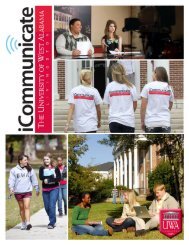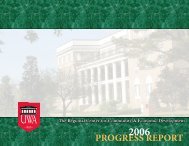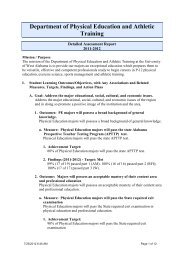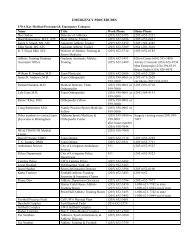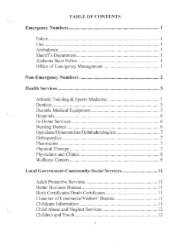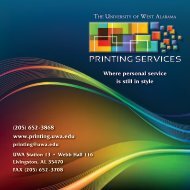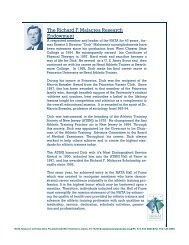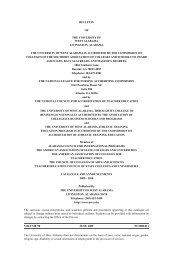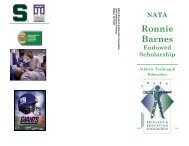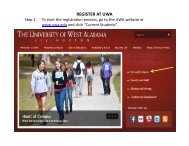table of contents - UWA Athletic Training & Sports Medicine Center
table of contents - UWA Athletic Training & Sports Medicine Center
table of contents - UWA Athletic Training & Sports Medicine Center
Create successful ePaper yourself
Turn your PDF publications into a flip-book with our unique Google optimized e-Paper software.
<strong>UWA</strong> Emergency Action PlanCross Country Emergency Procedure (Anywhere on campus)1. When an injury occurs, the attending athletic trainer should approach the athlete to evaluatethe injury. If the injury is life threatening the athletic trainer or student should have eitherthe coach or another teammate go to the nearest phone (undetermined at this time, due todaily changes in practice areas) or use an onsite cellular phone and activate the local EMSservice and inform them <strong>of</strong> the emergency. Also, call the campus police and have theminform the head athletic trainer or one <strong>of</strong> the senior staff athletic trainers <strong>of</strong> the injury.He/she should then report back to the attending athletic trainer.2. While someone is enacting the EMS system the attending athletic trainer should do aprimary survey and check the level <strong>of</strong> consciousness, if possible, or if the case <strong>of</strong> a head orspinal injury hold c-spine and wait. After enacting the EMS system and reporting to theattending athletic trainer, he/she should be instructed to help the attending athletic trainer bygoing and clearing a path to the injured athlete and directing EMS personnel to the scene.(There cannot be an established EMS route due to practice not restricted to onelocation)3. The attending athletic trainer must be aware that the athlete could go into shock at any timeafter an injury, so it is very important that the athletic trainer be able to recognize the earlysigns <strong>of</strong> shock and be able to manage it. The athlete should not be moved unless absolutelynecessary.4. When the ambulance arrives at the field and the EMT's approach the athlete, the attendingathletic trainer should give them all <strong>of</strong> the information gathered such as, the mechanism <strong>of</strong>injury, vital signs, time <strong>of</strong> injury, and progressing level <strong>of</strong> consciousness. When theambulance is preparing to leave the athletic trainer should have a copy <strong>of</strong> the athlete'sinsurance and brief medical outline to leave with the EMT’s. The attending athletic trainershould make sure they find out where the athlete is being taken. Once the ambulance hasleft, the attending student should relay the information to one <strong>of</strong> the senior staff athletictrainers.Location <strong>of</strong> all phonesPhones for emergency actions are available for the following sports at the following locations inthe event that an onsite cellular phone is not accessible:1. If a cellular phone is available it can be used at any location on campus to enact theEMS by dialing 9112. <strong>UWA</strong> Cross Country Clubhouse: There is no phone located in the cross countrycoach’s <strong>of</strong>fice. The nearest available land line is located at Tartt Baseball Field (seeabove #6) or at the Lake LU manager’s <strong>of</strong>fice.82




